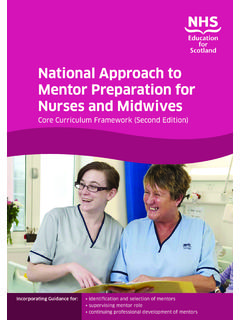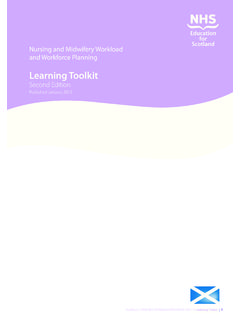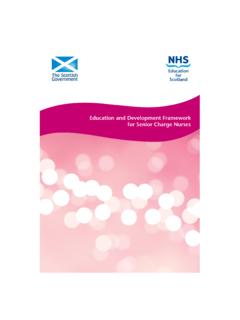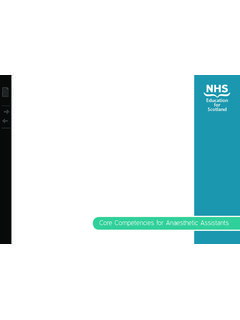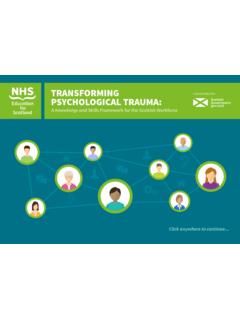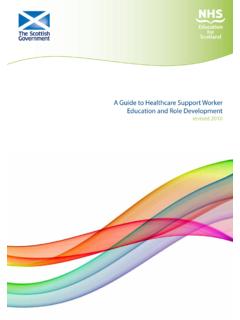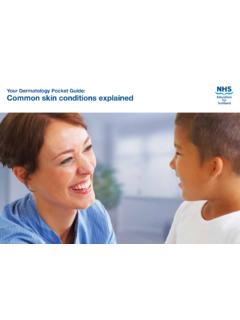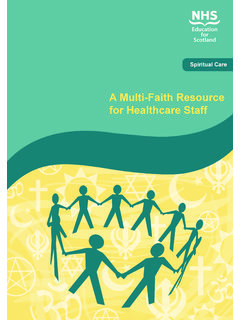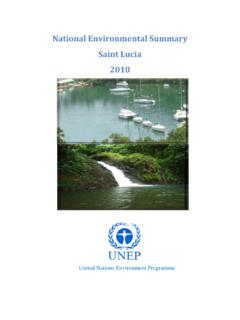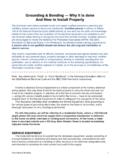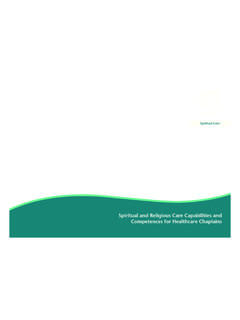Transcription of The development, implementation and ... - nes.scot.nhs.uk
1 The development, implementation and evaluation of a hub and spoke model for practice learning Final Project Report For NHS education for scotland January 2014 Authors Dr Jacqueline McCallum, Senior Lecturer GCU Dr Chris Darbyshire, Senior Lecturer GCU Jean Greig, Head of Department GCU GCU/N ES H ub and Spok e Project Fi nal Repo rt J an 2014 Page i CONTENTS Page EXECUTIVE SUMMARY REPORT FINAL PROJECT REPORT 1 SECTION 1: PROJECT ORIGINS, RATIONALE, AND HUB AND SPOKE 3 MODEL DEVELOPMENT Background and context to the project 3 Rationale for the hub and spoke practice learning model 3 SECTION 2: implementation WORK 2011-2013 6 Initial project steering and working group 6 implementation : Hub developments and student cohorts 7 implementation : spoke placement developments 8 Examples of innovative practice 8 SECTION 3: EVALUATION, RESEARCH DESIGN AND METHODS 9 Ethical issues 9 Evaluation design 9 Data collection methods 9 Data analysis 10 SECTION 4.
2 EVALUATION FINDINGS 11 Students evaluation of how prepared they are for their first 11 Hub practice learning experience Reasons for requests by the students/mentors to change the hub Practice learning environment 16 Students , mentors and PEFs experience of the first year of the Hub and spoke model of practice learning 17 Students understanding of person centred care 32 Completion of documentation 38 Failing to fail 39 SECTION 5: DISCUSSION 40 Introduction 40 Theme 1: Preparedness for Hub and Spoke 40 Theme 2: The Hub and Spoke process 42 Theme 3: Ownership and Socialisation into the profession 43 GCU/N ES H ub and Spok e Project Fi nal Repo rt J an 2014 Page ii Theme 4: Support and Development 44 Conclusion 44 Limitations 46 SECTION 6: CONCLUSION AND RECOMMENDATIONS 47 SECTION 7.
3 DISSEMINATION 49 References 50 Appendices 52 GCU/N ES H ub and Spok e Project Fi nal Repo rt J an 2014 Page iii List of Tables Table 1 Participant numbers for first practice learning experience 12 student questionnaire Table 2 Results for first practice learning experience student 12 questionnaire Table 3 Number of students who completed the first year student 17 experience questionnaire Table 4 Results of student s evaluation of the hub practice learning 18 experience Table 5 Results of mentor s evaluation of the hub practice learning 22 experience List of Figures Figure 1 Results from students understanding of person centred care 33 GCU/N ES H ub and Spok e Project Fi nal Repo rt J an 2014 Page 1 EXECUTIVE SUMMARY REPORT This summary report briefly describes the implementation and evaluation of the hub and spoke practice model project for all fields of nursing practice, the outcomes achieved and the conclusions reached as a result of the work undertaken.
4 Project Specification 1. Enhanced use of existing practice learning resources and exploration of new practice learning opportunities 2. Appropriate breadth and depth of student experiences in a wide variety of practice learning environments 3. Increased awareness of, and contribution to, measures of practice learning quality by SCNs, mentors and students 4. Strengthening of partnership working between GCU, NHS GG&C and NES to support piloting of placement quality monitoring/feedback through sharing of data regarding quality, utilisation and capacity 5. implementation of the hub and spoke model of practice learning to all undergraduate nursing students at Glasgow Caledonian University.
5 6. Dissemination of the results and recommendations of the hub and spoke model of practice learning for a large cohort of students from each field of nursing. Project Description Current NHS reconfiguration, the increased demands of an all graduate profession, and changes to the practice learning experiences that emphasise inter professional learning recognises that as a profession we need to consider alternatives to the present system of providing nursing students with practice experience (Mallabar and Turner 2004). It is intended that the proposed practice learning pattern Hub and Spoke - would enhance the student s practice learning experience by shifting the emphasis from a university dictated regime to a more collaborative learning experience where the mentor and student would be free to shape the student s learning experiences.
6 Among other gains the student could more readily follow the service user journey in the spirit of individualised client focused care which would accord with models of care such us Barker s (2008) Tidal Model, and has the potential to optimise the building of an interpersonal relationship between student and mentor to maximise learning opportunities (Mannix et al 2006). This pattern of attending practice learning and university would allow for closer integration of the student s university experience (theory) and practice learning experience (practice). Students can bring their reflections on and observations of practice into university more frequently and in a more immediate way and the cognitive tasks of linking theory to practice could be more readily achieved.
7 Person-centred practice and building of therapeutic relationships cannot be GCU/N ES H ub and Spok e Project Fi nal Repo rt J an 2014 Page 2 accomplished in a rushed manner simply to meet the current demands of organisational practice learning experience duration. Robertson et al (2007) acknowledge that the central barrier to developing effective person-centred practice is lack of time. It may be assumed that if students of nursing spend longer periods of time with clients/patients, mentors and other members of the multidisciplinary team, developing and sustaining these relationships over an extended timeframe, the delivery of effective, collaborative client/patient- focused care packages would be enhanced to the benefit of the service user.
8 The Hub and Spoke model has the potential to lay the foundations of a future practice focused model of action learning (Marlow et al 2008). The Hub and Spoke model for practice learning experience on the undergraduate nursing programmes at Glasgow Caledonian University was based on current NES funded evaluation from three implementation sites in 2011 [Edinburgh Napier University, University of Stirling, Robert Gordon University]. The key characteristic of the GCU model is that the student is allocated to a practice learning area for an extended duration which can range from six weeks to three years. This is termed the hub practice learning experience. Following negotiation the student then may go to a number of secondary or spoke practice learning environments.
9 These spokes may be anything from a single visit to a more prolonged period depending on the learning needs of the student. Outcomes The evaluation took a multi-method approach using a range of methods to gather relevant data from variety of stakeholders including student nurses, mentors and practice/care home education facilitators (PEF/CHEF). The project achieved its stated specifications and specifically found that: The hub and spoke model is an effective and efficient practice learning model for pre registration nursing programmes The hub and spoke model is associated with positive student outcomes in terms of belongingness, person centred care, clinical skills, and professional role development The hub and spoke model is appropriate for all fields of nursing while recognising that each field will have unique demands due to the changing nature of practice in health care.
10 We would suggest that this model will be an invaluable robust quality assurance tool to the further development of practice learning opportunities within the health and social integration agenda, specifically in mental health and learning disabilities. The hub and spoke model does generate a sense of inclusiveness and ownership for practice staff in the process of developing practice learning experiences as they can be more involved in the development of learning experiences, promote effective sharing of learning, and develop a robust evaluation of student performance over time which will promote valid and reliable measurement of competence by the end of the student journey.
